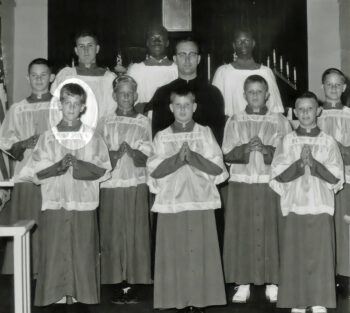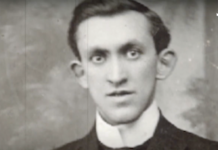By Mike Shreve —
Moses prophetically declared ten plagues that would come upon Egypt, because they had enslaved the seed of Abraham and Pharaoh would not let them go. When it came time for the ninth plague, God commanded Moses, “Stretch out your hand toward heaven, that there may be darkness over the land of Egypt, darkness which may even be felt” (Ex. 10:21)
And it happened! Darkness prevailed for three days, so intense, so overwhelming, so ominous, that the Egyptians did not leave their homes. Miraculously, though, the “children of Israel had light in their dwellings”—and so it should be now in a supernatural sense (Ex. 10:22). That intriguing account parallels something very similar—on a spiritual level—that happens globally every year. There are three consecutive days of spiritual darkness and deception that settle over much of the world, two of which are disguised in the form of religious “holy days”: Halloween, All Saints Day, and All Souls Day (Oct. 31-Nov. 2).
HALLOWEEN (OCTOBER 31)
This day of masquerading in costumes and children going door-to-door, saying, “Trick or treat,” looks innocent, but it hides a very sinister past. Originally, it was an ancient Celtic and pagan celebration called Samhain (pronounced sow-in)—a dreadful night full of occult rituals performed by Druid priests on the cusp of the dark months of winter (symbolic of death).
It included the wearing of costumes (often animal skins and heads), not for fun, but in the hope of warding off evil ghosts. Witches and Wiccans to this day believe Halloween to be a day when communication with the spirit world, especially contacting the dead (necromancy) is most advantageous, because according to their belief system, the “veil” between the natural and spiritual realms is at its thinnest and most penetrable point.
Halloween is the high, “unholy” day of Satanism. It swings drastically to the dark and evil side of the spiritual spectrum, a time when gruesome images of skeletons, zombies, gravestones, blood, vampires, black cats, spider webs, and snakes are seen everywhere. Even the jack-o-lantern pumpkins on porches have a dark back-story that involves a man, a trickster named Jack, who made a pact with the devil for monetary gain. When he died, as the myth goes, God refused him entrance into heaven and Satan refused him entrance into hell—so his ghost was cursed to roam the earth forever.
By the way, that light in the pumpkin—it represents a live coal from the fires of hell that Satan threw at Jack. Of course, it’s just a traditional myth, but . . . it reveals the personality of the season.
Most committed Christians recoil from participation in Halloween since evil is so blatantly enshrined. However, few realize that the next two days we are going to examine are filled with just as much spiritual darkness and deception.
ALL SAINTS DAY (NOVEMBER 1)

The term “Halloween” is a word that stems from “All Hallows Eve,” a reference to the night before “All Saints Day.”
Although most people are oblivious to it, October 31st and November 1st are spiritually connected in profound ways. In fact, the term “Halloween” is a word that stems from “All Hallows Eve,” a reference to the night before “All Saints Day.” (The word “hallow” means to venerate something as holy, or it can simply refer to a saint.)
So, what could be bad about a day set aside to celebrate saints, following a dark day that celebrates evil? Isn’t that positive progress? Not really! Not if you dig deeper into the symbolic meaning, doctrine, and purpose behind it.
Shortly after, in the eighth century, Pope Gregory III switched the date to November 1 when he dedicated a chapel at the Vatican honoring all martyrs and saints. As the doctrine of the canonization and the role of saints evolved in Catholicism, about two centuries later, it became a day when praying to the saints in heaven was a major emphasis. (For a deeper study of this concept and practice, go to the article titled, Is Praying to the Saints Biblically Correct?). Quite possibly, it was meant to substitute for Samhain and draw the devotion of the Celtic people away from their pagan practices.
Unfortunately, this tradition merely substituted one false spiritual activity for another, because it doesn’t work and it is nothing less than the forbidden pagan practice of necromancy, veiled in what seems to be acceptable, biblical terminology. And yes, I did say “forbidden.” Deuteronomy 18:9-13 commands:
When you come into the land which the LORD your God is giving you, you shall not learn to follow the abominations of those nations. There shall not be found among you anyone who makes his son or his pass through the fire, or one who practices witchcraft, or a soothsayer, or one who interprets omens, or a sorcerer, or one who conjures spells, or a medium, or a spiritist, or one who calls up the dead. For all who do these things are an abomination to the LORD, and because of these abominations the LORD your God drives them out from before you. You shall be blameless before the LORD your God.
A necromancer, like a medium or a spiritualist, is someone who attempts to contact the dead. The word “abomination” means something utterly revolting. This occult practice is detestable to God because it opens the door to false, supernatural manifestations. Those participating come under the influence of evil spirits. God abhors the spiritual damage that results and the deception that is propagated. God was not denying His people a legitimate and powerful spiritual experience; He was and is protecting them from a web of esoteric delusion in this area.
Disregarding this command from Deuteronomy, Catholics enthusiastically persist in “praying to the saints”—imploring departed “saints” in heaven to intercede in their behalf. Such a non-biblical observance is both theologically erroneous and logically impossible. All Saints Day is comparable to a global séance with millions of eager participants. Tragically, it is not a tradition offering true worship to the Most High God.
Can it have any other negative results? Well, we do have the biblical record of Saul going to the witch of Endor in his attempt to contact the prophet Samuel who had died for spiritual guidance. That didn’t go so well for Saul, did it? Within a day’s time, he and his sons died during a battle with the Philistines. (See 1 Samuel 28-31.) If praying to the saints was a viable practice, Saul would have been praised in the Bible for his spiritual resourcefulness in a time of stress, instead of coming under judgment for his rebellion and witchcraft.
TWO MORE REASONS PRAYING TO THE SAINTS IS WRONG
There are two more reasons this practice of praying to the saints is wrong.
First, according to the biblical standard, all believers are saints, not just those who have shown exceptional holiness, which can be easily proved by the following salutations in Paul’s epistles:
Paul, an apostle of Jesus Christ by the will of God, to the saints who are in Ephesus, and faithful in Christ Jesus. (Ephesians 1:1)
Paul, an apostle of Jesus Christ by the will of God, and Timothy our brother, to the saints and faithful brethren in Christ who are in Colosse: Grace to you and peace from God our Father and the Lord Jesus Christ. (Colossians 1:1-2).
The word “saint” simply means one who has been “sanctified” (meaning cleansed from the defilement of sin, made holy, and consecrated to God). The Catholic Catechism actually does refer to all Catholics (only Catholics) as “the assembly of all the saints” (CCC #946), but because of the Church’s emphasis on qualification for sainthood through canonization, this is not a commonly claimed status among its adherents.
Second, logistically, such a practice is impossible. Think about it! There are approximately 1.3 billion Catholics in the world. Just suppose half of them pray to Peter on All Saints Days (650 million). Break that down into a smaller time segment, dividing it by 1,440 (the number of minutes in a day). That’s about 451,388 people calling on Peter every minute.
Can you imagine trying to intelligently process nearly half-a-million conversations all at once, only to be replaced by another half-million prayerful people within 60 seconds? I do well to focus on one person at a time talking to me. To be able to handle such a tsunami of requests for intercession, Peter would have to be omniscient (all knowing) and omnipresent (existing everywhere), because he would have to be personally aware of mediating in 451,388 situations and locations simultaneously. Yet omniscience and omnipresence are attributes that can only be attributed to God. Besides, the Scripture boldly and plainly proclaims:
There is one God and one Mediator between God and men, the Man Christ Jesus. (1 Timothy 2:5)
A normal Catholic response to the quoting of this verse is to justify praying to the saints by insisting, “If we interpret this verse to mean we should never ask for saints in heaven to pray for us, then we should not request fellow believers in this world to pray for us either. We would only present our petitions to Jesus.” That’s a valid point, however, there is a huge difference between one Christian asking another Christian to pray about something (which is encouraged biblically), and millions of Christians simultaneously asking a departed believer to pray (which is discouraged biblically).
ALL SOULS DAY (NOVEMBER 2)

All Souls Day–especially a time to pray loved ones out of purgatory (according to those who believe in that doctrine)
What could be wrong with setting aside a day to remember all who have passed through the veil of death to the other side? Nothing, if it ended there. However, in Catholicism, All Souls Day is especially a time to pray for those believed to be in Purgatory.
This ‘holy day’ originated with Odilo of Cluny, the Abbot of a Benedictine monastery in France who lived from 962-1049 A.D., almost a millennium after the establishment of the Church in this world. Such a practice was never known among the early disciples.
In Purgatory, an imagined intermediate realm, Catholics who die with unconfessed venial sins, or with temporal punishments still due for confessed mortal or venial sins, who are not holy enough to enter heaven, are purportedly purged and perfected to finally be made worthy of heaven. Though technically, time does not exist in Purgatory, the process can be quite lengthy. Believing this doctrine robs the cross of its glory and grace of its power and plunges believers into a righteousness-by-religious-works mentality.
The primary go-to scripture that Catholics use to support the idea of Purgatory is 1 Corinthians 3:11-15:
For no other foundation can anyone lay than that which is laid, which is Jesus Christ. Now if anyone builds on this foundation with gold, silver, precious stones, wood, hay, straw, each one’s work will become clear; for the Day will declare it, because it will be revealed by fire; and the fire will test each one’s work, of what sort it is. If anyone’s work which he has built on it endures, he will receive a reward. If anyone’s work is burned, he will suffer loss; but he himself will be saved, yet so as through fire.
Clearly, Paul was not talking about a long, protracted period of anguish and misery in a purgatorial realm, but a single Day of supernatural revelation (he said, “The Day will declare it”). He was referencing “the Day” of the Lord’s return, when Jesus will descend from heaven “in flaming fire and all His holy angels” (2 Thessalonians 1:8).
In one blazing, apocalyptic moment of spectacular power and glory, He will determine whether the works of His sons and daughters are worthy of an eternal reward, or if they were futile religious pursuits based on doctrinal errors, mere Church traditions, or manmade, non-biblical rituals.
He will baptize us in such an intense, holy fire that mortality will be swallowed up by life. If what we have believed or done religiously in our Christian walk was not inspired by God or in alignment with His Word and will, we may suffer loss (the loss of that time in our lives that could have been devoted to God in a more perfect way). But we will be saved—if Jesus is truly the foundation of our lives.
The Bible does not teach Purgatory; there are only two destinations after death. To propose a third, temporary realm of suffering and purging is to create false hope and open a door to compromise in the lives of believers who are then more prone to accepting less commitment in their spiritual walk. Instead of zealously striving to overcome and to enter the strait gate, they might be inclined to accept defeat, thinking they will just have to spend more time in Purgatory. (See the article on PURGATORY–Does It Exist?.)
THE CONCLUSION
So, what is my conclusion? These three days are all times of spiritual darkness and religious deception, not just Halloween. Only the first is blatantly evil; the other two are clothed in the costume of Bible-based religious fervor. Quite often, the adherents who believe and participate are deeply sincere in their love for God—yet all three celebratory days are just as wrong as the festival of Samhain on which Halloween is based. No wonder those who are sensitive spiritually can, in a sense, “feel” the darkness.
Mike Shreve (front row, left side) is very familiar with Catholicism. In his early years, he served as an altar boy. Later on, he was on his way to the monastery when a close encounter with death dramatically changed his direction in life. He recently published a full length book titled, The Beliefs of the Catholic Church: 25 Questions Comparing Doctrines, Practices and Traditions to Scripture. www.toCatholicswithlove.org
served as an altar boy. Later on, he was on his way to the monastery when a close encounter with death dramatically changed his direction in life. He recently published a full length book titled, The Beliefs of the Catholic Church: 25 Questions Comparing Doctrines, Practices and Traditions to Scripture. www.toCatholicswithlove.org



